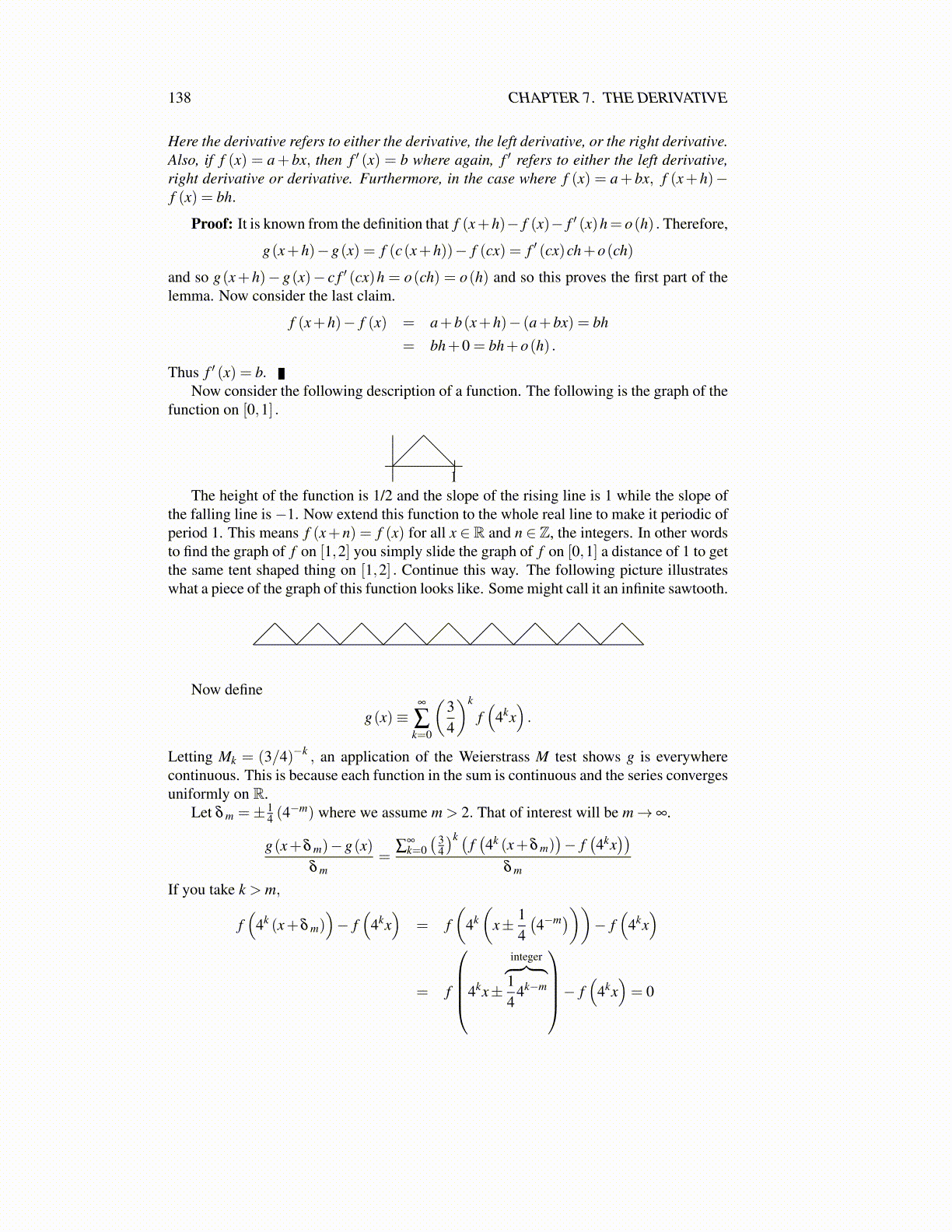
138 CHAPTER 7. THE DERIVATIVE
This is called the chain rule. In this rule, for the sake of simiplicity, assume the derivativesare real derivatives, not derivatives from the right or the left. If f (t) = tn where n is anyinteger, then
f ′ (t) = ntn−1. (7.12)
Also, whenever f ′ (t) exists, f ′ (t) = limh→0f (t+h)− f (t)
h where this definition can be adjustedin the case where the derivative is a right or left derivative by letting h > 0 or h < 0 onlyand considering a one sided limit. This is equivalent to f ′ (t) = lims→t
f (s)− f (t)t−s with the
limit being one sided in the case of a left or right derivative.
Proof: 7.10 is left for you. Consider 7.11
f g(t +h)− f g(t) = f (t +h)g(t +h)− f (t)g(t +h)+ f (t)g(t +h)− f (t)g(t)
= g(t +h)( f (t +h)− f (t))+ f (t)(g(t +h)−g(t))
= g(t +h)(
f ′ (t)h+o(h))+ f (t)
(g′ (t)h+o(h)
)= g(t) f ′ (t)h+ f (t)g′ (t)h+ f (t)o(h)
+(g(t +h)−g(t)) f ′ (t)h+g(t +h)o(h)
= g(t) f ′ (t)h+ f (t)g′ (t)h+o(h)
because by Lemma 7.3.6, g is continuous at t and so (g(t +h)−g(t)) f ′ (t)h= o(h) . Whilef (t)o(h) and g(t +h)o(h) are both o(h) . This proves 7.11.
Next consider the chain rule. By Lemma 7.3.6 again,
f ◦g(t +h)− f ◦g(t) = f (g(t +h))− f (g(t))
= f (g(t)+(g(t +h)−g(t)))− f (g(t))
= f ′ (g(t))(g(t +h)−g(t))+o((g(t +h)−g(t)))
= f ′ (g(t))(g(t +h)−g(t))+o(h)
= f ′ (g(t))(g′ (t)h+o(h)
)+o(h)
= f ′ (g(t))g′ (t)h+o(h) .
This proves the chain rule.Now consider the claim about f (t) = tn for n an integer. If n = 0,1 the desired
conclusion follows from Lemma 7.4.1. Suppose the claim is true for n ≥ 1. Then letfn+1 (t) = tn+1 = fn (t) t where fn (t) ≡ tn. Then by the product rule, induction and thevalidity of the assertion for n = 1,
f ′n+1 (t) = f ′n (t) t + fn (t) = tntn−1 + tn = (n+1)tn+1
and so the assertion is proved for all n≥ 0. Consider now n =−1.
(t +h)−1− t−1 =−1
t (t +h)h =−1t2 h+
(−1
t (t +h)+
1t2
)h
=−1t2 h+
h2
t2 (t +h)=− 1
t2 h+o(h) = (−1) t−2h+o(h)